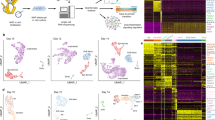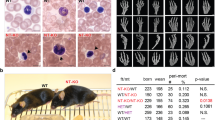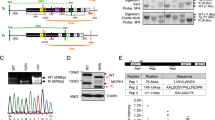Abstract
The amnionless gene, Amn, on mouse chromosome 12 encodes a type I transmembrane protein that is expressed in the extraembryonic visceral layer during gastrulation1. Mice homozygous with respect to the amn mutation generated by a transgene insertion have no amnion2,3. The embryos are severely compromised, surviving to the tenth day of gestation but seem to lack the mesodermal layers that normally produce the trunk4. The Amn protein has one transmembrane domain separating a larger, N-terminal extracellular region and a smaller, C-terminal cytoplasmic region. The extracellular region harbors a cysteine-rich domain resembling those occurring in Chordin, found in Xenopus laevis embryos, and Sog, found in Drosophila melanogaster. As these cysteine-rich domains bind bone morphogenetic proteins (Bmps), it has been speculated that the cysteine-rich domain in Amn also binds Bmps4. We show that homozygous mutations affecting exons 1–4 of human AMN lead to selective malabsorption of vitamin B12 (a phenotype associated with megaloblastic anemia 1, MGA1; OMIM 261100; refs. 5,6) in otherwise normal individuals, suggesting that the 5′ end of AMN is dispensable for embryonic development but necessary for absorption of vitamin B12. When the 5′ end of AMN is truncated by mutations, translation is initiated from alternative downstream start codons.
This is a preview of subscription content, access via your institution
Access options
Subscribe to this journal
Receive 12 print issues and online access
$209.00 per year
only $17.42 per issue
Buy this article
- Purchase on Springer Link
- Instant access to full article PDF
Prices may be subject to local taxes which are calculated during checkout



Similar content being viewed by others
References
Kalantry, S. et al. The amnionless gene, essential for mouse gastrulation, encodes a visceral-endoderm–specific protein with an extracellular cysteine-rich domain. Nat. Genet. 27, 412–416 (2001).
Wang, X. et al. A candidate gene for the amnionless gastrulation stage mouse mutation encodes a TRAF-related protein. Dev. Biol. 177, 274–290 (1996).
Tomihara-Newberger, C. et al. The amn gene product is required in extraembryonic tissues for the generation of middle primitive streak derivatives. Dev. Biol. 204, 34–54 (1998).
Dunn, N.R. & Hogan, B.L. How does the mouse get its trunk? Nat. Genet. 27, 351–352 (2001).
Imerslund, O. Idiopathic chronic megaloblastic anemia in children. Acta Paediatr. Scand. Suppl, 1–115 (1960).
Grasbeck, R., Gordon, R., Kantero, I. & Kuhlback B. Selective vitamin B12 malabsorption and proteinuria in young people. Acta Med. Scand. 167, 289–296 (1960).
Aminoff, M. et al. Mutations in CUBN, encoding the intrinsic factor-vitamin B12 receptor, cubilin, cause hereditary megaloblastic anaemia 1. Nat. Genet. 21, 309–313 (1999).
Broch, H., Imerslund, O., Monn, E., Hovig, T. & Seip, M. Imerslund–Grasbeck anemia. A long-term follow-up study. Acta Paediatr. Scand. 73, 248–253 (1984).
Moestrup, S.K. et al. The intrinsic factor–vitamin B12 receptor and target of teratogenic antibodies is a megalin-binding peripheral membrane protein with homology to developmental proteins. J. Biol. Chem. 273, 5235–5242 (1998).
Christensen, E.I. & Birn, H. Megalin and cubilin: synergistic endocytic receptors in renal proximal tubule. Am. J. Physiol. Renal Physiol. 280, F562–F573 (2001).
Schuler, G.D. et al. A gene map of the human genome. Science 274, 540–546 (1996).
Wright, F.A. et al. A draft annotation and overview of the human genome. Genome Biol. 2, RESEARCH0025 (2001).
Xu, D., Kozyraki, R., Newman, T.C. & Fyfe, J.C. Genetic evidence of an accessory activity required specifically for cubilin brush-border expression and intrinsic factor-cobalamin absorption. Blood 94, 3604–3606 (1999).
Kozak, M. Initiation of translation in prokaryotes and eukaryotes. Gene 234, 187–208 (1999).
Zhang, M.Q. Identification of human gene core promoters in silico. Genome Res. 8, 319–326 (1998).
Davuluri, R.V., Grosse, I. & Zhang, M.Q. Computational identification of promoters and first exons in the human genome. Nat. Genet. 29, 412–417 (2001).
Yamashita, T. et al. Clinical variability of Fanconi anemia (type C) results from expression of an amino terminal truncated Fanconi anemia complementation group C polypeptide with partial activity. Blood 87, 4424–4432 (1996).
Jeffery, C.J. Moonlighting proteins. Trends Biochem. Sci. 24, 8–11 (1999).
Eng, C. RET proto-oncogene in the development of human cancer. J. Clin. Oncol. 17, 380–393 (1999).
Vajo, Z., Francomano, C.A. & Wilkin, D.J. The molecular and genetic basis of fibroblast growth factor receptor 3 disorders: the achondroplasia family of skeletal dysplasias, Muenke craniosynostosis, and Crouzon syndrome with acanthosis nigricans. Endocr. Rev. 21, 23–39 (2000).
Genschel, J. & Schmidt, H.H. Mutations in the LMNA gene encoding lamin A/C. Hum. Mutat. 16, 451–459 (2000).
Lehmann, A.R. The xeroderma pigmentosum group D (XPD) gene: one gene, two functions, three diseases. Genes Dev. 15, 15–23 (2001).
Sambrook, J., Fritsch, E.F. & Maniatis, T. Molecular Cloning: A Laboratory Manual Vol. 3 (Cold Spring Harbor Laboratory, Cold Spring Harbor, 1989).
Acknowledgements
We thank P. Lahermo and J. Kere of the Finnish Genome Center for genome-wide linkage analysis and advice; R. Gräsbeck, T. Joensuu, A.-E. Lehesjoki and G. Leone for ideas, suggestions and constructive criticism; Z. Li and R. Bisson for expert technical support with construct cloning; S. Lindh for sample collection; and K. Green-Church for protein mass spectrometry. This work was supported by the Liv och Hälsa Foundation and the US National Cancer Institute. S.M.T. is supported by the Swiss National Science Foundation and the Swiss Foundation for Medical-Biological Grants.
Author information
Authors and Affiliations
Corresponding author
Ethics declarations
Competing interests
The authors declare no competing financial interests.
Supplementary information
Rights and permissions
About this article
Cite this article
Tanner, S., Aminoff, M., Wright, F. et al. Amnionless, essential for mouse gastrulation, is mutated in recessive hereditary megaloblastic anemia. Nat Genet 33, 426–429 (2003). https://doi.org/10.1038/ng1098
Received:
Accepted:
Published:
Issue Date:
DOI: https://doi.org/10.1038/ng1098
This article is cited by
-
Imerslund-Gräsbeck syndrome: a comprehensive review of reported cases
Orphanet Journal of Rare Diseases (2023)
-
CUBN gene mutations may cause focal segmental glomerulosclerosis (FSGS) in children
BMC Nephrology (2022)
-
Shared genetic background between children and adults with attention deficit/hyperactivity disorder
Neuropsychopharmacology (2020)
-
Structural assembly of the megadalton-sized receptor for intestinal vitamin B12 uptake and kidney protein reabsorption
Nature Communications (2018)
-
Vitamin B12 deficiency
Nature Reviews Disease Primers (2017)



